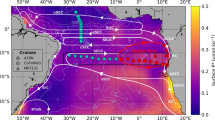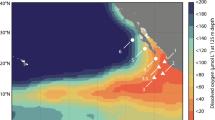Abstract
Primary production in over half of the world’s oceans is limited by fixed nitrogen availability. The main loss term from the fixed nitrogen inventory is the production of dinitrogen gas (N2) by heterotrophic denitrification or the more recently discovered autotrophic process, anaerobic ammonia oxidation (anammox). Oceanic oxygen minimum zones (OMZ) are responsible for about 35% of oceanic N2 production and up to half of that occurs in the Arabian Sea1. Although denitrification was long thought to be the only loss term, it has recently been argued that anammox alone is responsible for fixed nitrogen loss in the OMZs2,3,4. Here we measure denitrification and anammox rates and quantify the abundance of denitrifying and anammox bacteria in the OMZ regions of the Eastern Tropical South Pacific and the Arabian Sea. We find that denitrification rather than anammox dominates the N2 loss term in the Arabian Sea, the largest and most intense OMZ in the world ocean. In seven of eight experiments in the Arabian Sea denitrification is responsible for 87–99% of the total N2 production. The dominance of denitrification is reproducible using two independent isotope incubation methods. In contrast, anammox is dominant in the Eastern Tropical South Pacific OMZ, as detected using one of the isotope incubation methods, as previously reported3,5. The abundance of denitrifying bacteria always exceeded that of anammox bacteria by up to 7- and 19-fold in the Eastern Tropical South Pacific and Arabian Sea, respectively. Geographic and temporal variability in carbon supply may be responsible for the different contributions of denitrification and anammox in these two OMZs. The large contribution of denitrification to N2 loss in the Arabian Sea indicates the global significance of denitrification to the oceanic nitrogen budget.
This is a preview of subscription content, access via your institution
Access options
Subscribe to this journal
Receive 51 print issues and online access
$199.00 per year
only $3.90 per issue
Buy this article
- Purchase on Springer Link
- Instant access to full article PDF
Prices may be subject to local taxes which are calculated during checkout


Similar content being viewed by others
References
Devol, A. H. et al. Denitrification rates and excess nitrogen gas concentrations in the Arabian Sea oxygen deficient zone. Deep-Sea Res. 53, 1533–1547 (2006)
Kuypers, M. M. M. et al. Massive nitrogen loss from the Benguela upwelling system through anaerobic ammonium oxidation. Proc. Natl Acad. Sci. USA 102, 6478–6483 (2005)
Thamdrup, B. et al. Anaerobic ammonium oxidation in the oxygen-deficient waters off northern Chile. Limnol. Oceanogr. 51, 2145–2156 (2006)
Lam, P. et al. Revising the nitrogen cycle in the Peruvian oxygen minimum zone. Proc. Natl Acad. Sci. USA 106, 4752–4757 (2009)
Hamersley, M. R. et al. Anaerobic ammonium oxidation in the Peruvian oxygen minimum zone. Limnol. Oceanogr. 52, 923–933 (2007)
Codispoti, L. et al. The oceanic fixed nitrogen and nitrous oxide budgets: moving targets as we enter the Anthropocene? Sci. Mar. 65, 85–105 (2001)
Zehr, J. P. et al. Unicellular cyanobacteria fix N2 in the subtropical North Pacific Ocean. Nature 412, 635–638 (2001)
Kuypers, M. M. et al. Massive nitrogen loss from the Benguela upwelling system through anaerobic ammonium oxidation. Proc. Natl Acad. Sci. USA 102 10.11073/pnas.0502088102 (2005)
Dalsgaard, T., Thamdrup, B. & Canfield, D. E. Anaerobic ammonium oxidation (anammox) in the marine environment. Res. Microbiol. 156, 457–464 (2005)
Castro-Gonzalez, M., Braker, G., Farias, L. & Ulloa, O. Communities of nirS-type denitrifiers in the water column of the oxygen minimum zone in the eastern South Pacific. Environ. Microbiol. 10.1111/j.1462–2920 (2005)
Jayakumar, D. A., Francis, C. A., Naqvi, S. W. A. & Ward, B. B. Diversity of nitrite reductase genes (nirS) in the denitrifying water column of the coastal Arabian Sea. Aq. Microb. Ecol. 34, 69–78 (2004)
Jayakumar, A., Naqvi, S. W. A. & Ward, B. B. in Indian Ocean Biogeochemical Processes and Ecological Variability (eds Wiggert, J. D., Hood, R. R., Naqvi, S. W. A., Brink, K. H., & Smith, S. L.) (AGV Geophysical Monograph series, American Geophysical Union, in the press)
Schmid, M. C. et al. Anaerobic ammonium-oxidizing bacteria in marine environments: widespread occurrence but low diversity. Environ. Microbiol. 9, 1476–1484 (2007)
Woebken, D. et al. A microdiversity study of anammox bacteria reveals a novel Candidatus Scalindua phylotype in marine oxygen minimum zones. Environ. Microbiol. 10, 3106–3119 (2008)
Dalsgaard, T., Canfield, D. E., Petersen, J., Thamdrup, B. & Acuna-Gonzalez, J. N2 production by the anammox reaction in the anoxic water column of Golfo Dulce, Costa Rica. Nature 422, 606–608 (2003)
Ward, B. B. et al. Organic carbon, and not copper, controls denitrification in oxygen minimum zones of the ocean. Deep-Sea Res. I 10.1016/j.dsr.2008.07.005 (2008)
Nicholls, J. C., Davies, I. M. & Trimmer, M. High-resolution profiles and nitrogen isotope tracing reveal a dominant source of nitrous oxide and multiple pathways of nitrogen gas formation in the central Arabian Sea. Limnol. Oceanogr. 52, 156–168 (2007)
Ward, B. B. et al. Denitrification in the hypolimnion of permanently ice-covered Lake Bonney, Antarctica. Aq. Microb. Ecol. 38, 295–307 (2005)
Braker, G., Fesefeldt, A. & Witzel, K.-P. Development of PCR primer systems for amplification of nitrite reductase genes (nirK and nirS) to detect denitrifying bacteria in environmental samples. Appl. Environ. Microbiol. 64, 3769–3775 (1998)
Schmid, M. et al. Candidatus “Scalindua broda”, sp. nov., Candidatus “Scalindua wagneri”, sp. nov., two new species of anaerobic ammonia oxidizing bacteria. Syst. Appl. Microbiol. 26, 529–538 (2003)
Zumft, W. G. Cell biology and molecular basis of denitrification. Microbiol. Mol. Biol. Rev. 61, 533–616 (1997)
Strous, M. et al. Deciphering the evolution and metabolism of an anammox bacterium from a community genome. Nature 440, 790–794 (2006)
Jayakumar, A., O'Mullan, G. D., Naqvi, S. W. A. & Ward, B. B. Denitrifying bacterial community composition changes associated with stages of denitrification in oxygen minimum zones. Microb. Ecol. 58, 350–362 (2009)
Farias, L. et al. Denitrification and nitrous oxide cycling within the upper oxycline of the eastern tropical South Pacific oxygen minimum zone. Limnol. Oceanogr. 54, 132–144 (2009)
Ducklow, H. W. et al. Heterotrophic bacterioplankton in the Arabian Sea: Basinwide response to year-round high primary productivity. Deep-Sea Res. II 48, 1303–1323 (2001)
Emerson, S. E., Stump, C., Wilbur, D. & Quay, P. Accurate measurement of O2, N2, and Ar gases in water and the solubility of N2 . Mar. Chem. 74, 337–347 (1999)
Nielsen, L. Denitrification in sediment determined from nitrogen isotope pairing. FEMS Microbiol. Ecol. 86, 357–362 (1992)
Thamdrup, B. & Dalsgaard, T. Production of N2 through anaerobic ammonium oxidation coupled to nitrate reduction in marine sediments. Appl. Environ. Microbiol. 68, 1312–1318 (2002)
Acknowledgements
W. Naqvi helped make it possible to schedule the RV Roger Revelle to work in the Arabian Sea in 2007. We thank the master and crews of the RV Knorr and RV Roger Revelle, and J. Moffett who was chief scientist on the Knorr. This work was supported by NSF grants to B.B.W., A.H.D. and A.J.
Author Contributions B.B.W., A.H.D. and A.J. designed the Arabian Sea experiments and participated in all the fieldwork; J.J.R. designed the ETSP and Arabian Sea exetainer experiments and performed them in the ETSP; S.E.B. and B.B.W. performed the exetainer experiments in the Arabian Sea; J.J.R. made the exetainer mass spec measurements for both Arabian Sea and ETSP; B.X.C. and A.H.D. made the mass spectrometer measurements for the bag experiments; B.B.W., A.H.D., A.J., S.E.B. and B.X.C. carried out the bag experiments in the Arabian Sea; A.J. performed the Q-PCR experiments; H.N. and A.P. provided the nitrite and nitrate data for Fig. 1a and b; B.B.W. wrote the paper with input from A.H.D., A.J., S.E.B., B.X.C. and J.J.R.
Author information
Authors and Affiliations
Corresponding author
Supplementary information
Supplementary Figures
This file contains Supplementary Figure S1 and Legend. (PDF 80 kb)
PowerPoint slides
Rights and permissions
About this article
Cite this article
Ward, B., Devol, A., Rich, J. et al. Denitrification as the dominant nitrogen loss process in the Arabian Sea. Nature 461, 78–81 (2009). https://doi.org/10.1038/nature08276
Received:
Accepted:
Issue Date:
DOI: https://doi.org/10.1038/nature08276
This article is cited by
-
Effects of Cascade Reservoirs on Spatiotemporal Dynamics of the Sedimentary Bacterial Community: Co-occurrence Patterns, Assembly Mechanisms, and Potential Functions
Microbial Ecology (2024)
-
Partitioning of the denitrification pathway and other nitrite metabolisms within global oxygen deficient zones
ISME Communications (2023)
-
Vertical Microbial Profiling of Arabian Sea Oxygen Minimal Zone Reveals Complex Bacterial Communities and Distinct Functional Implications
Microbial Ecology (2023)
-
Microbial community structure and exploration of bioremediation enzymes: functional metagenomics insight into Arabian Sea sediments
Molecular Genetics and Genomics (2023)
-
The marine nitrogen cycle: new developments and global change
Nature Reviews Microbiology (2022)
Comments
By submitting a comment you agree to abide by our Terms and Community Guidelines. If you find something abusive or that does not comply with our terms or guidelines please flag it as inappropriate.



